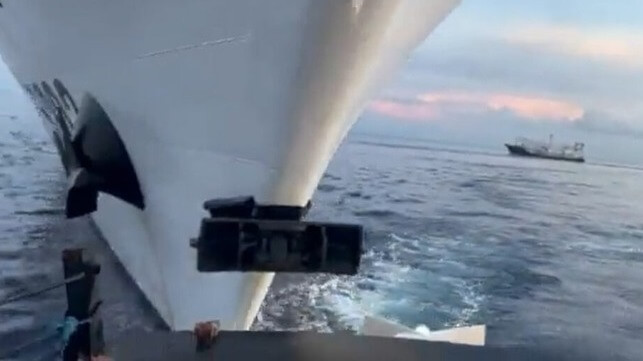China Coast Guard Cutter Hits Philippine Supply Boat in S. China Sea

Early Sunday morning, the Philippine Coast Guard was escorting a resupply run to the military outpost on Second Thomas Shoal when a China Coast Guard cutter collided with a Philippine supply boat in the convoy, the PCG said in a statement. Later in the same mission, a Chinese maritime militia trawler "bumped" a PCG patrol vessel.
The resupply runs to Second Thomas Shoal involve tense standoffs between the China Coast Guard and the Philippine Coast Guard, and the PCG has to carry out its mission despite resistance from multiple Chinese vessels. China claims ownership of the Spratly Islands and surrounding waters, including areas within the Philippine exclusive economic zone, like Second Thomas Shoal. Beijing has repeatedly ordered Manila to withdraw its garrison from the Philippine station - a wrecked LST, intentionally grounded on the reef 24 years ago - but Philippine forces have held out, and the resupply missions keep bypassing the Chinese blockade.
In previous confrontations, Chinese forces have used aggressive maneuvering, water cannons and laser target illuminators to deter Philippine supply boats. The PCG has long warned that these tactics increase the risk of collision, and Sunday's mission appears to confirm that prediction. At about 0600 hours Sunday morning, China Coast Guard cutter CCG 5203 engaged in "dangerous blocking maneuvers" to cut off a contracted Philippine supply boat, Unaiza May 2, according to the PCG. The maneuver resulted in a collision at a position about 13 nautical miles away from the station on Second Thomas Shoal.
During the same operation, a Chinese maritime militia vessel - pennant number 00003 - made contact with the Philippine patrol vessel MRRV 4409 on the port side.
Videos from the scene (below) appear to show that both incidents involved light contact and resulted in little damage.
LOOK: Videos of the latest collision incident during a regular rotation and resupply mission in the West Philippine Sea on Sunday, October 22.#AFPyoucanTRUST pic.twitter.com/TqHsK8ESE3
— Armed Forces of the Philippines (@TeamAFP) October 22, 2023
The other Philippine supply vessel in the convoy, Unaiza May 1, made it through to the outpost to deliver supplies and replacement personnel.
In a statement, the Philippine government's task force for the South China Sea called the Chinese blockade force's actions "dangerous, irresponsible and illegal," as well as a violation of Philipping sovereignty and jurisdiction.
In 2016, the Permanent Court of Arbitration in the Hague ruled that China's historically-based claims to the South China Sea are without merit under international law. China has ignored the ruling and has deployed its "gray zone" forces - white-hulled coast guard cutters and militia-operated "commercial" fishing trawlers - to enforce its claims.
Philippines suspends military exchange program with China
As maritime confrontation between China and Philippines escalates in the South China Sea, the Philippines has suspended its military exchange program with Beijing. The move is a protest by the Philippines over numerous run-ins with the China Coast Guard.
Speaking to local media last week, the Chief of Staff of the Armed Forces of Philippines (AFP), General Romeo Brawner Jr., said that the decision to suspend the military exchange program with China was contemplated after an August incident in which a Chinese coast guard vessel sprayed water cannons at Philippines military transport ships in Spratly islands.
The military exchange program between Manila and Beijing was launched in 2007. It entails Philippines sending five military officers (in the rank of lieutenant colonel or higher) to China for 6-12 months of training every year. The Philippine National Police Academy also sends some of its cadets for specialized training to the Beijing Military Academy and other training facilities run by the People’s Liberation Army (PLA).
With diplomatic relations between Beijing and Manila increasingly strained, a group of Filipino senators in August demanded that AFP explain why the military exchange program still exists while China continues to harass Philippines.
“This is indeed alarming. This has to be explained. We have not been accepting cadets from our military treaty ally while we have been sending our soldiers to the country harassing us in the West Philippine Sea. What’s the rationale behind this?”, said Senator Francis Tolentino during a public hearing of the Senate Committee on national defense and security in August.
